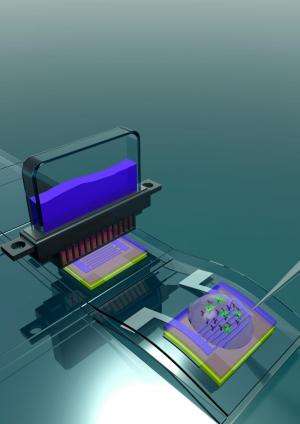An inkjet-printed field-effect transistor for label-free biosensing

Thin-film transistors (TFTs) are powerful devices in semiconductor manufacturing and form the basis of countless electronic devices, such as memory chips, photovoltaic cells, logic gates, and sensors. An interesting alternative to inorganic TFTs (silicon) is organic TFTs (OTFTs), which offer the possibility of mass production by using the conventional printing technology and working with low-cost materials. However, numerous inherent problems still remain, especially concerning the long-term stability and lack of reliability.
Researchers from the Institut Català de Nanociència i Nanotecnologia's (ICN2 – Catalan Institute of Nanoscience and Nanotechnology) Nanobioelectronics and Biosensors Group, led by the ICREA Research Prof Arben Merkoçi, work to get OTFTs closer to devices which can be fully applied in field applications. The Group published in the last issue of Advanced Functional Materials an article describing a flexible, biological field-effect transistor (BioFET) for use in biosensing. The fabrication, structure, materials optimization, electrical characteristics, and functionality of the starting OTFT and final BioFET are also discussed. The authors of the article are Dr Mariana Medina-Sánchez, Dr Carme Martínez-Domingo, Dr Eloi Ramon[, and ICREA Research Prof Arben Merkoçi.
A fully integrated organic BioFET was designed, fabricated and tested for label-free protein detection. It was made by inkjet printing of an organic field-effect transistor (OFET) and subsequent functionalization of the insulator with specific antibodies. ICN2 researchers analysed different insulators, the biofunctionalization of the surface, the selective adhesion of target proteins to the BioFET, the repeatability with different devices and the roughness of functionalized and immobilized protein structures. Finally, as proof of concept, the BioFET platform was successfully tested for detection of the model protein, human immunoglobulin G (HIgG).
The BioFET designed at ICN2 represents an important starting point for the design and fabrication of flexible, organic biosensing devices by inkjet printing. The reproducibility in the fabrication process, the development of functional inks and extension of this technology to a wider array of substrates are still unsolved issues. The authors are confident that once this technology has matured, it will be amenable to miniaturization for integration into a fully functional device for point-of-care diagnosis.
More information:
Mariana Medina-Sánchez, Carme Martínez-Domingo, Eloi Ramon, Arben Merkoçi. An Inkjet-Printed Field-Effect Transistor for Label-Free Biosensing. Advanced Functional Materials. Article first published online: 31 JUL 2014. DOI: 10.1002/adfm.201401180
http://onlinelibrary.wiley.com/doi/10.1002/adfm.201401180/abstract
Journal information: Advanced Functional Materials




















